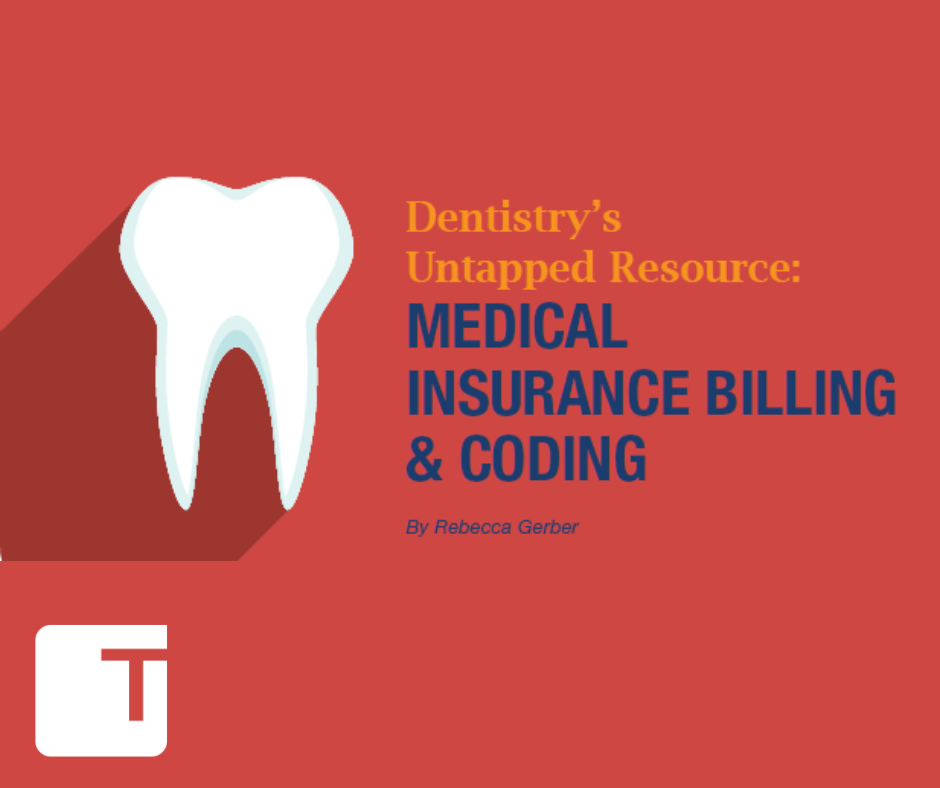Originally published May 2018 in Trojan Today.
In today’s competitive dental market, more and more dentists are finding it prudent and profitable to bill medically necessary dental procedures to medical insurance carriers. Submitting selected dental treatment to medical carriers not only provides a valuable service, but it can increase the bottom line of the practice through greater case acceptance.
Offering this benefit to patients who qualify may help them accept needed dentistry that otherwise may not be affordable. Procedures connected to bone, anatomy, and the alveolus can be sent to medical carriers, thus saving the dental benefits for tooth-related procedures. Medical insurance plans carry higher deductibles; however, there are no frequencies or maximums involved, as there are with dental insurance benefits.
The number of patients who may benefit from medical billing will vary according to the demographics of the practice. Clientele, location, and specialty services offered are major factors in whether a dental provider decides to offer this service.
Some of the dental procedures that can be submitted to medical carriers include:
- Biopsies
- CT scans
- Oral cancer screenings
- TMD appliances
- Sleep apnea appliances
- Services on patients needing dentistry before chemotherapy or transplant surgery
- Procedures related to trauma
Establishing a systemic link is the most important part of medical billing. For example, when submitting for endodontic procedures, it is essential to establish a medical connection that necessitates endo therapy. The majority of endodontic procedures may not be covered, unless infection is present and either compromising or exacerbating a patient’s medical condition. A letter of medical necessity from the patient’s physician is a necessary document when submitting endo treatment to the medical carrier.
Appliance therapy, or interceptive orthodontics, may be a covered benefit if the patient exhibits bone anomalies that possibly can be corrected with a nonsurgical approach. In that case, a CT scan and all follow-up adjustments can be submitted to the medical insurance carrier. CT scans and oral cancer screenings can be submitted for detection of oral cancer or other diseases of the mouth. However, a CT scan and report cannot be submitted for an implant if a systemic link is not present.
Additional requirements for medical billing include increased documentation, such as SOAP notes.
SOAP format is universally known and accepted:
SUBJECTIVE: What the patient says
OBJECTIVE: The provider’s findings after x-rays, models, and diagnostic tests
ASSESSMENT: The provider’s diagnosis
PLAN: Treatment plan, including the treatment and all-follow up visits
It’s also mandatory to update all health histories with the medical carrier’s name, address, and a thorough review of the patient’s systems. The health history needs to include questions regarding the Respiratory, Circulatory, G.I., Neuro-Muscular, and Endocrine systems, along with medications used and lifestyle habits.
The role of the doctor is to understand these requirements and clinically evaluate head, neck, and sinus issues, while documenting all medical concerns. It is important to make sure all the proper records and reports are available when contacting the insurance carriers for authorization of treatment.
Vital reports include:
- Comprehensive medical exams
- Letters of medical necessity
- Emergency room reports
- Police reports, if needed
All documents should contain diagnosis codes as well as procedure codes. Make sure the language used contains medical terminology, not dental. For instance, a Panorex is called an Orthopantogram or an OPG.
In an average general dental practice, there are a limited number of dental codes that can be translated into medical CPT codes. It is important for the provider to choose codes based on the diagnosis of the patient in the chair. It is essential to be as specific as possible and not allow anyone to assume that procedure codes are one code fits all. Remember, the doctor is painting a picture with codes, and the medical carrier insists on specificity. There are excellent websites and books available that can help providers and billers choose the proper medical codes.
The last step is to submit the claim. There are many clearinghouses and medical billing software programs available at little or no cost to the dental practice. Make sure that whatever is chosen is user-friendly and practical, based on the volume of medical claims generated monthly. The office can also outsource the billing to a company which specializes in processing medical claims. When using an outside service, obtain a signed Business Associates Agreement. Customized superbills and encounter forms can help establish consistent communication when outsourcing. They can also be helpful for internal communication within the office.
Medical Billing for Dental Practices is in the embryonic stages and is an art, not a science. However, many dental benefits are now becoming embedded in medical plans. In the foreseeable future, it is important to have knowledge of medical billing and proper documentation, so the practice administrator can assess and make a conclusion on how to make a medical billing system an integral part of the practice.

Rebecca Gerber, RDA, is the Owner and Lead Instructor at Academy of Dental Practice Careers, Inc. ADPC is a Dental Front Office Training Facility, specializing in educating front office personnel and organizing systems for the dental practice.
For more information regarding Medical Billing or any other classes: info@dentalpracticecareers.com, 877-235-7100, or www.dentalpracticecareers.com

